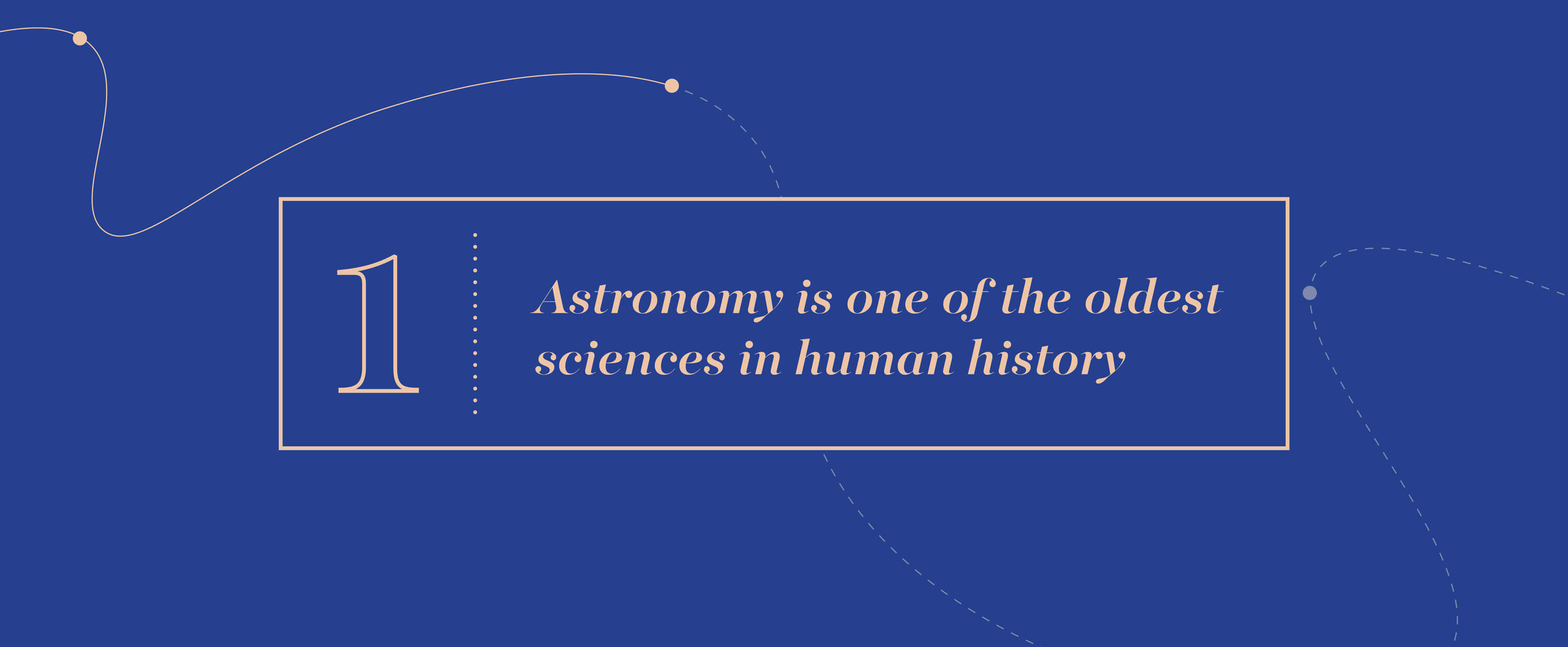
1.1
Understanding the sky and the movements of the Sun and planets was one of the first attempts to understand the natural world
The first records of astronomical observations come from drawings and artefacts created by prehistoric people, documenting what they saw in the sky. In ancient cultures, Astronomy was related to religious and mythological beliefs. Astronomical phenomena were used to measure time and to create calendars, allowing such cultures to plan daily and seasonal events.
1.2
Earlier cultures imagined patterns connecting stars in the night sky
Patterns in the night sky formed by connecting stars using imaginary lines are called constellations. The earliest constellations were defined by early cultures. These recognisable groups of stars were often connected to cultural stories and mythology from cultures such as Greek, Mayan, Native American and Chinese. In modern Astronomy, constellations are well-defined regions of the sky, which combine both ancient constellations and those defined in the 15th, 16th, 17th and 18th centuries. Some cultures, such as the Indigenous Australians and the indigenous people of South America, also identified patterns using the dark silhouettes in the luminous band of the Milky Way.
1.3
Astronomy has inspired and is represented in the art and culture of many civilisations
Over the centuries, artists, poets, writers, and many creative thinkers, have used the night sky either as inspiration and/or as subjects in their work. Astronomical themes can be seen represented, for example, in paintings, sculptures, music, movies and literature. These works have used the observable motifs seen in the night to directly, or indirectly, communicate the essence, beauty and mystery of the night sky. The universality of art and its intimate connection to culture, can thus be a powerful means to make people appreciate not only the innate beauty of celestial objects and phenomena, rather the knowledge we have acquired about them. This increases the worldwide interest in astronomy and promotes a cross cultural understanding encompassed by the notion of being under one sky.
1.4
Astronomy provided important timekeeping knowledge, essential for ancient agriculture
In many ancient cultures, astronomy was developed to increase the accuracy of farming calendars. As an example, Egyptians developed a calendar based on their observations of the star Sirius, using it to determine the annual flooding of the river Nile.
1.5
Astronomy was important for navigators in the past
Many civilisations used the position of the stars and other celestial objects to navigate the land, seas and oceans. Celestial navigation is still taught to this day.
1.6
Astronomy, by using the scientific method, is different from astrology
Until pre-modern times, the distinction between astronomy and astrology was vague. Today astronomy and astrology are clearly distinguished from each other. Astronomy is a science and astrology is not. Astrology uses positions of celestial objects to predict future events. However, extensive studies of astrology and its predictions show that astrology is not accurate in its predictions and is without any scientific foundation.
1.7
Earth was believed, by most earlier cultures, to be the centre of the Universe
Most early cultures, with notable exceptions by some of the Greek astronomers active around 300 BCE, believed that Earth was the centre of the Universe. This Geocentric view lasted for over two millennia in European and Asian Cultures until the so-called Copernican Revolution in the XVI Century. Modern astronomers have found that the Universe appears to have no specific centre in space.
1.8
The century-long Copernican revolution led to the Sun replacing Earth as the accepted centre of the Solar System
In the 16th century, Copernicus proposed arguments for the Heliocentric theory in which the Sun was the centre of the Universe and Earth moved around it. Although we now know that the Sun is not the centre of the Universe, it is the centre of the Solar System and the Copernican Heliocentrism theory was revolutionary at that time, contributing to the development of modern Astronomy.
1.9
Over 400 years ago, astronomers undertook the first methodical observations within astronomy using a telescope
Although he did not invent the telescope, Galileo was the first to use it for scientific purposes. His improvements of the refracting telescope led him to discoveries such as the phases of Venus and the four largest moons of Jupiter, which are still referred to as Galilean moons. His discoveries provided compelling evidence that supported the Heliocentric view of the Universe.
1.10
Planet Earth is approximately spherical in shape, and this has been illustrated for centuries in many different ways
Some early cultures in many areas of the world have described Earth as a flat plane or disk as part of their description of the Universe. The idea that Earth is a sphere has been around for a few millennia and has been a significant part of the worldviews of many cultures, becoming the dominant paradigm more than 1000 years ago. There are numerous empirical ways to test that Earth is approximately spherical in shape (it is technically referred to as an oblate spheroid). One of the earliest mathematical methods was by Eratosthenes, who measured the circumference of Earth by analysing the lengths of shadows cast by sticks at different locations in ancient Egypt (3rd century BCE).
